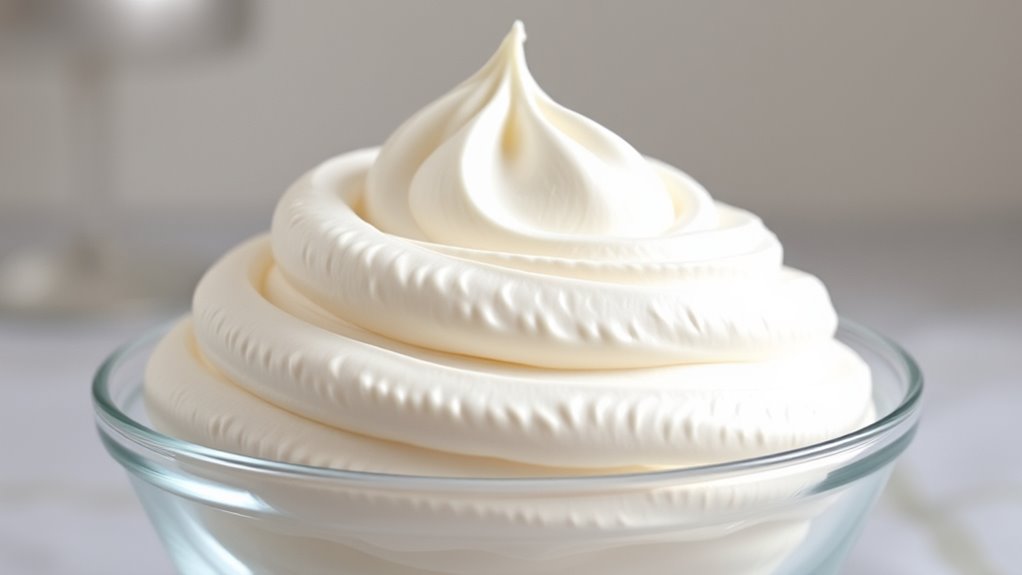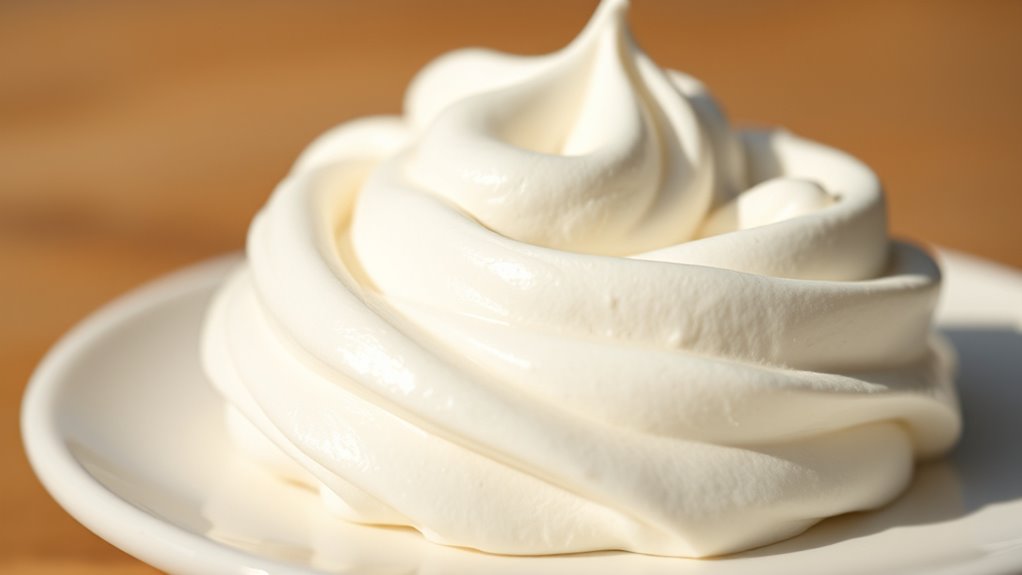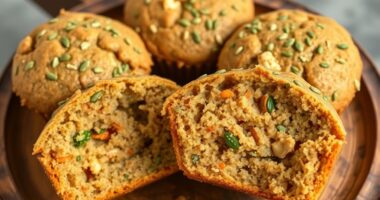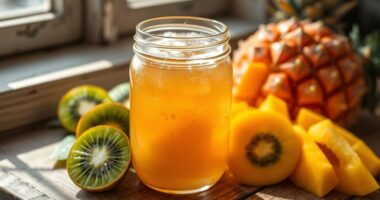To whip foolproof aquafaba meringue, start with chilled aquafaba in a clean, metal or glass bowl. Use an electric mixer on high, adding a pinch of cream of tartar or lemon juice early to stabilize. Whip until shiny, thick peaks form that stand upright, then gradually incorporate superfine sugar, beating until stiff peaks appear. Perfecting this process guarantees cloud-like, stable meringue textures every time—keep going to discover all the tips for flawless results.
Key Takeaways
- Use chilled aquafaba in a clean, dry metal or glass bowl for best whipping results.
- Add a pinch of cream of tartar or lemon juice during initial whipping to stabilize the foam.
- Whip on high speed until stiff, glossy peaks form that stand upright without collapsing.
- Gradually add superfine sugar, beating thoroughly after each addition until fully dissolved.
- Bake at low temperature for a crisp exterior and soft interior, ensuring a stable, fluffy meringue every time.

If you’ve ever wanted a vegan-friendly alternative to traditional meringue, aquafaba offers a perfect solution. This liquid from canned chickpeas or cooking beans can be whipped into a fluffy, marshmallow-like consistency that closely resembles egg whites. Achieving that perfect, cloud-like texture hinges on understanding how to create stiff peaks and maintain sugar stability. When whipped correctly, aquafaba transforms into a glossy, stable foam that holds its shape, making it ideal for meringues, pavlovas, and other desserts. The key is to focus on the right technique and ingredient ratios, guaranteeing you get a light, airy texture every time.
Start with chilled aquafaba—cold liquid whips more efficiently and forms better peaks. Pour it into a clean, dry mixing bowl, ideally glass or metal, as plastic bowls may retain oils that hinder whipping. Using an electric mixer on high speed, whisk the aquafaba until it begins to foam, then add a pinch of cream of tartar or lemon juice. These acidic stabilizers help build a more stable foam by encouraging the proteins and sugars to bond properly. As you continue to beat, you’ll notice the foam becoming glossy and thicker. When you lift the beaters, the mixture should form stiff peaks, standing upright without collapsing. This stage indicates you’ve reached the ideal consistency for meringue.
The next essential step involves adding sugar gradually. For sugar stability, it’s best to incorporate superfine or caster sugar, which dissolves quickly and evenly, preventing a gritty texture. Add the sugar in small increments, beating continuously after each addition. This gradual process allows the sugar to dissolve thoroughly, creating a stable foam with the necessary sheen. Proper sugar incorporation ensures the meringue maintains its structure during baking and prevents weeping or collapse later on. Patience here is vital; rushing the sugar addition can undermine the stability you’ve worked so hard to achieve.
Once you’ve achieved stiff peaks and sugar stability, you can pipe or spoon the meringue onto your baking sheet. Bake at a low temperature to preserve that light, airy quality. The result will be a crisp exterior with a soft, marshmallow-like interior—just as delightful as traditional egg-based meringue, but entirely vegan. With practice, you’ll master the art of whipping aquafaba into perfect stiff peaks and stabilizing it with sugar, giving you a versatile, cruelty-free dessert base that’s foolproof every time.
Frequently Asked Questions
Can Aquafaba Be Used as an Egg Substitute in Baking?
Yes, aquafaba works well as an egg replacement in baking, especially for vegan baking. You can whip it into a fluffy meringue or use it as a binder in recipes like cookies and cakes. Its natural emulsifying properties help mimic eggs’ functions, making your baked goods moist and tender. So, next time you bake vegan, try aquafaba—you’ll find it a versatile, effective ingredient that delivers consistent results every time.
How Long Does Aquafaba Meringue Stay Stable?
Aquafaba meringue stays stable for about 24 to 48 hours if you store it properly. For best results, keep it in an airtight container in the refrigerator and avoid exposing it to humidity or heat. Refrigeration tips include gently covering the meringue and avoiding stirring or disturbing it. To maintain its fluffy texture, serve it soon after making, as it may start to deflate or become sticky over time.
Is There a Specific Type of Chickpeas Best for Aquafaba?
Choosing the right chickpeas is like picking the perfect paint color—you want the best for a flawless finish. For aquafaba extraction, canned chickpeas, especially organic or plain varieties, work best because they produce a more stable foam. Chickpea varieties like Kabuli or Desi are good options, but avoid flavored or seasoned beans. Sticking to simple, high-quality chickpeas guarantees your meringue stays fluffy and stable every time.
Can I Freeze Leftover Aquafaba Meringue?
Yes, you can freeze leftover aquafaba meringue using proper freezing techniques. To do this, transfer it to an airtight container, leaving some space for expansion, and label it with the date. For best results, store it for up to 3 months. When you’re ready to use it, thaw it in the fridge and re-whip briefly to restore its fluffiness. Just keep in mind that freezing may slightly affect its texture.
Are There Any Common Mistakes to Avoid When Making Aquafaba Meringue?
When making aquafaba meringue, avoid overbeating, which can cause it to collapse or become grainy. Use proper whipping techniques, ensuring you beat at the right speed and until stiff peaks form. Keep an eye on your mixture to prevent overmixing, and make sure your bowl and beaters are clean. These overbeating tips help you achieve that perfect, cloud-fluffy meringue every time without fail.
Conclusion
Now that you’ve mastered this foolproof aquafaba meringue, imagine the possibilities. Will you top a dazzling pie or craft delicate cookies? The fluffy clouds are just waiting to transform your desserts—and trust me, once you see how effortlessly perfect they turn out, you’ll wonder why you ever hesitated. So go ahead, whip up your masterpiece, and prepare to impress. The secret’s in your hands, and the best part? The magic is just beginning.










